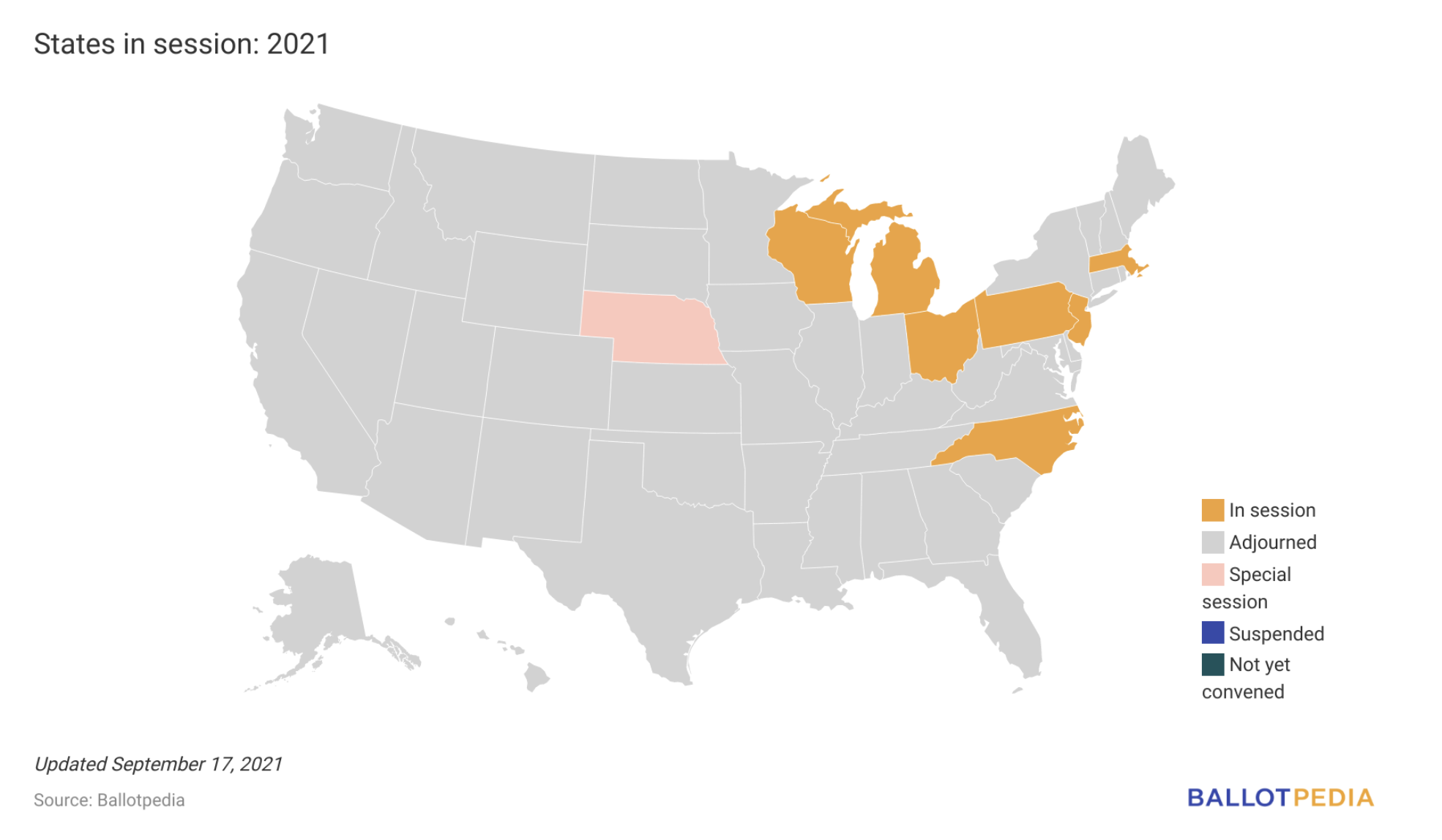|
|
Welcome to The State and Local Tap
|
|
|
September 18, 2021
|
|
|
|
Our weekly summary of state & local news highlights a summary of the California gubernatorial recall election and updates in the Boston mayoral primary. Read all about it in this week’s edition of the State & Local Tap. |
|
|
|
BALLOTPEDIA |
|
|
|
|
|
|
California voters retain Gov. Gavin Newsom (D)
California voters retained Gov. Gavin Newsom (D) in the recall election on Sept. 14. With all precincts partially reporting, 63.9% voted to retain Newsom, while 36.1% voted to recall him. A majority vote was required to recall Newsom.
Among the replacement candidates, Larry Elder (R) received the largest share of the votes at 47% followed by Kevin Paffrath (D) at 10%.
Forty-six candidates, including nine Democrats and 24 Republicans, ran in the election. The candidates to receive the most media attention and perform best in polls before the election were YouTuber Kevin Paffrath (D), 2018 gubernatorial candidate John Cox (R), radio host Larry Elder (R), former San Diego Mayor Kevin Faulconer (R), California State Board of Equalization member Ted Gaines (R), former Olympian and television personality Caitlyn Jenner (R), and Assemblyman Kevin Kiley (R).
Recall supporters said Newsom mishandled the state's response to the coronavirus pandemic, did not do enough to address the state's homelessness rate, and supported sanctuary city policies and water rationing. In a March 2021 response, Newsom called the effort a "Republican recall — backed by the RNC, anti-mask and anti-vax extremists, and pro-Trump forces who want to overturn the last election and have opposed much of what we have done to fight the pandemic." Newsom was elected governor in 2018 with 61.9% of the vote.
Since 1911, there have been 55 attempts to recall a California governor. The only successful recall campaign was in 2003 when voters recalled then-Gov. Gray Davis (D). Arnold Schwarzenegger (R) was elected as Davis' replacement. In that election, 135 candidates ran and the winner received 48.6% of the vote.
Wu and Essaibi George advance from Boston mayoral primary
Michelle Wu and Annissa Essaibi George advanced from Boston's mayoral primary election on Sept. 14. Wu received 33.4% of the vote to Essaibi George's 22.5%. Eight candidates were on the ballot.
Wu and Essaibi George are both at-large city councilors. They defeated fellow city councilors Andrea Campbell and Kim Janey (who received 19.7% and 19.5% of the vote, respectively) along with three other candidates to advance to the Nov. 2 general election. Janey is also the city's acting mayor, having succeeded Marty Walsh in March 2021 when he became secretary of labor in President Joe Biden's (D) administration.
Media outlets have described Essaibi George as the more moderate of the leading candidates in the primary and Wu as one of the more progressive candidates. A former teacher and a member of the council since 2016, Essaibi George has emphasized her opposition to defunding the police and has discussed housing, schools, and public safety as priority issues. Wu has highlighted her climate plan, including a Boston Green New Deal, and her support for rent control. Wu has been on the city council since 2014.
Either will be the first woman to serve as Boston's mayor. Essaibi George and Wu have emphasized that they are the children of immigrants. Wu's parents are Taiwanese. Essaibi George's mother is from Poland and her father is from Tunisia.
Sonoma County, Calif., district attorney retains office after voters defeat recall effort
A recall election seeking to remove Jill Ravitch from her position as the district attorney of Sonoma County, Calif., was on the ballot on Sept. 14. A majority of voters (79.9%) cast ballots against the recall, defeating the effort and keeping Ravitch in office.
The candidate filing deadline passed on July 1, but no candidates filed to run in the replacement race. However, two write-in candidates—Omar Figueroa and Joey Castagnola—filed to run afterward.
The recall effort began in October 2020. Recall supporters said Ravitch had ignored issues of inequality, injustice, and fire safety; failed to hold corporations accountable for environmental issues; prevented the release of police body camera recordings; disproportionately incarcerated minorities; and abused her powers to pursue personal vendettas.
In response to the recall effort, Ravitch defended her record and said, “I’m so proud of the work the District Attorney’s Office does, and it’s such an honor to lead a dedicated group of professionals who work hard every day to ensure justice. [...] These allegations strike not just at me but the work my office does, and that’s unfortunate.”
Ravitch took office as district attorney in 2011. Prior to the filing of the notice of intent to recall, Ravitch had announced that she would not seek re-election when her term ends in 2022.
In the first half of 2021, Ballotpedia tracked 164 recall efforts against 262 officials. This was the most recall efforts for this point in the year since the first half of 2016, when we tracked 189 recall efforts against 265 officials. |
|
|
|
|
|
|
Redistricting Roundup: Ohio Redistricting Commission approves new state legislative maps along party lines
Ohio: The Ohio Redistricting Commission approved new district maps shortly after midnight on Sept. 16 for the Ohio state Senate and the Ohio House of Representatives in a 5-2 vote. The two Democratic members of the commission, state Rep. Emilia Sykes (D) and state Sen. Vernon Sykes (D), were the two dissenting votes. Since the map was approved along partisan lines, it will only last for four years, rather than 10, as outlined in the 2015 constitutional amendment creating the commission.
Senate President Matt Huffman (R), a member of the commission, estimated that the new maps would create 62 Republican seats and 37 Democratic seats in the House, and 23 Republican seats and 10 Democratic seats in the Senate. Cleveland.com reported that Democrats on the commission agreed with the Senate estimates, but said the new House map would create 65 Republican seats and 34 Democratic seats.
Following the enactment of the maps, Huffman released a statement saying: “These house and senate maps will be in place for the next four years, and represent an important first step towards approving the next map that will complete the decade. [...] I’m convinced we could’ve reached a ten-year map. However, special interests pressured democrats to not support it, asking voters to extend the deadline to accomplish that.”
Leading up to the vote, Emilia Sykes disapproved of the maps as overly partisan, saying she would “call it offensive and plain wrong to move forward this map [...] to put forth something that so arrogantly flies in the face of what people, our voters, asked us to do, not once, but twice.”
Commission members Gov. Mike DeWine (R) and Secretary of State Frank LaRose (R) expressed disapproval of the maps and said they expected court challenges to follow their vote. DeWine said: “Along with the secretary of state I will vote to send this matter forward but it will not be the end of it. We know that this matter will be in court. [...] What I am sure in my heart is that this committee could have come up with a bill that was much more clearly constitutional.”
Iowa: On Sept. 14, the Iowa Supreme Court extended the deadline for state legislative redistricting to Dec. 1 due to delays in receiving data from the U.S. Census Bureau. The court said that because the process would not be complete by the state’s Sept. 15 constitutional deadline, it was exercising its responsibility and authority over redistricting.
The Iowa Temporary Redistricting Advisory Commission also released its first draft of proposed congressional and state legislative district maps on Sept. 16. Redistricting commissions or state legislative committees in Alaska, Colorado, Hawaii, Idaho, Indiana, Maine, Maryland, and Nebraska also released draft congressional or legislative maps.
Ballot measures update

Thirty-nine statewide measures have been certified for the 2021 ballot in nine states so far.
-
Statewide measures for 2021 are finalized. No new measures are expected to be added to the ballot.
Sixty statewide measures have been certified for the 2022 ballot in 29 states so far.
-
No new measures were certified for the 2022 ballot last week.
State legislative special elections
Sixty state legislative special elections have been scheduled in 20 states so far this year. Forty specials have taken place already. Heading into those races, Democrats had previously controlled 18 of the seats, and Republicans previously controlled 20. One seat flipped from Democratic control to Republican control, and one seat flipped from Republican control to Democratic control.
-
In special elections between 2011 and 2020, one party (either Republicans or Democrats) saw an average net gain of four seats nationally each year.
-
An average of 57 seats were filled through special elections in each of the past six even years (2010: 30, 2012: 46, 2014: 40, 2016: 65, 2018: 99, 2020: 59).
-
An average of 88 seats were filled through special elections in each of the past five odd years (2011: 94, 2013: 84, 2015: 89, 2017: 98, 2019: 77).
Upcoming special elections include:
Sept. 28
Oct. 5
Oct. 19
States in session

Seven states—Massachusetts, Michigan, New Jersey, North Carolina, Ohio, Pennsylvania, and Wisconsin—are in regular session. |
|
|
|
|
|
|
|
Join us on our mission to deliver unbiased and accurate information about American politics and policy to our millions of readers. Your support in 2021 will allow us to continue our mission to build the most comprehensive coverage of the nation’s rapidly changing political landscape. |
|
|
|
|
|